

Lisette Model (Austrian, 1901-1983), Lower East Side, New York, 1940s, gelatin
silver print, 19 1/2 x 15 1/2 inches, Kemper Museum of Contemporary
Art, Kansas City, MO.
Ansel Adams (American, 1902-1984). See landscape.
Manuel Álvarez Bravo (Mexican, 1902-2002)
Harold Edgerton (American, 1903-1990). Edgerton was a photographer and inventor. He used his invention of the stroboscope to produce stroboscopic photographs. Producing a flash of light as short as 1/1,000,000 second, the action stopping capabilities of the stroboscope enabled Edgerton to capture such high speed objects on film as a bullet piercing an apple, a bullet smashing a light bulb, and milk drops in mid-splash.
Walker Evans (American, 1903-1975), Kitchen Corner, Tenant Farmhouse, Hale County, Alabama, 1936, depicted: Alabama, United States of America, gelatin silver print, 19.5 x 16.1 cm (7 11/16 x 6 5/16 inches), Metropolitan Museum of Art, NY. See New Deal art.

Walker Evans, Penny Picture Display, 1936, gelatin-silver
print, 8 5/8 x 6 7/8 inches (21.9 x 17.5 cm), Metropolitan Museum of Art, NY.
Aaron Siskind (American, 1903-1991), Street Scene #3, Harlem, 1935, gelatin silver print, Michael C. Carlos Museum, Emory U, Atlanta, GA.
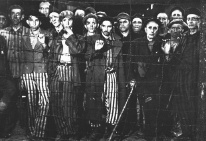
Margaret Bourke-White (American, 1904-1971),
Jewish
Prisoners at the Fence at Buchenwald, 1945, photograph.
At the end of World War II, Margaret Bourke-White was with General Patton's Third Amy when
they reached Buchenwald on the outskirts of Weimar. Patton was
so incensed by what he saw that he ordered his police to get
a thousand civilians to make them see with their own eyes what
their leaders had done. The MPs were so enraged they brought
back 2,000. Bourke-White said, "I saw and photographed the
piles of naked, lifeless bodies, the human skeletons in furnaces,
the living skeletons who would die the next day... and tattoed
skin for lampshades. Using the camera was almost a relief. It
interposed a slight barrier between myself and the horror in
front of me." LIFE published in their May 7, 1945 issue
many photographs of these atrocities, saying, "Dead men
will have indeed died in vain if live men refuse to look at them." See fascist aesthetic, Jewish art, and xenophobia.

Bill Brandt (British, born Germany, 1904-1983), Street Scene, London, 1936, gelatin silver print, .228 x .195 m (9 x 7 11/16 inches, National Gallery of Art, Washington D.C.
Andreas Feininger (American, born Germany, 1906-)

Henri Cartier-Bresson (French, 1908-2004), Seville, Spain, 1932, gelatin silver
print, 9 x 13 1/2 inches (22.9 x 34.3 cm), San Francisco Museum
of Modern Art
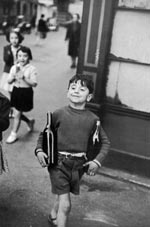
Henri Cartier-Bresson, Rue Mouffetard,
Paris, 1954, gelatin silver print, Milwaukee Art Museum.
Minor White (American, 1908-1976)
Wright Morris (American, 1910-)

Joe Rosenthal (American, 1911-), Soldiers Hoist the Stars and Stripes at Iwo Jima, February 23, 1945, photograph. This iconic photograph actually shows the second flag-raising to celebrate the recapture of the island from the Japanese. Although Rosenthal did not stage this scene at all, as was rumored, he has had to answer the rumor ever since 1945. Mitchell Landsberg's story for AP about the photo includes, "The battle for Iwo Jima was the costliest battle in Marine Corps history. Its toll of 6,821 Americans dead, 5,931 of them Marines, accounted for nearly one-third of all Marine Corps losses in all of World War II. Rosenthal's picture has been called the greatest photograph of all time. It may well be the most widely reproduced. It served as the symbol for the Seventh War Loan Drive, for which it was plastered on 3.5 million posters. It was used on a postage stamp and on the cover of countless magazines and newspapers. It served as the model for the Marine Corps War Memorial in Arlington, Va., a symbol forever of the valor and sacrifices of the U.S. Marines." See memorial.

Harry Callahan (American, 1912-1999), Untitled, 1946, gelatin silver print,
19.6 x 24.3 cm. (7 3/4 x 9 9/16 inches), Metropolitan Museum
of Art, NY. This is a close-up
look at sand and pebbles on the Lake Michigan beach at Chicago,
IL.
Harry Callahan (American, 1912-)
Robert Doisneau (French, 1912-1994)
Robert Capa (American, 1913-1954). Capa's philosophy for war photography was simple: "If a picture's bad, it's because you didn't get close enough."
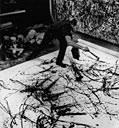
Hans Namuth (American, 1915-1990), Pollock painting, 1950, gelatin silver prints, National Portrait Gallery, Smithsonian Institution, Washington, D.C. This is one of at least five photographs Namuth made of Pollock painting. Their publication in Life magazine in 1951 caused a great sensation.
![]()
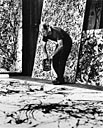
Here is a second one,
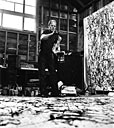
![]()
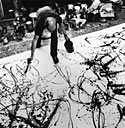
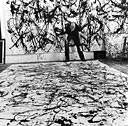
and a fifth.
Yevgeni Khaldei (Russian, 1917-)
Irving Penn (American, 1917-)

Irving Penn, Truman Capote, New York,
1965 (print 1986), platinum palladium print, Condé Nast
Publications, Inc.
Arnold Newman (American, 1918-)
W. Eugene Smith (American, 1918-1978)
Robert Frank (American)
See other examples:
Robert Adamson, Édouard Baldus, Hippolyte Bayard, Louis-Auguste Bisson, Mathew Brady, Julia Margaret Cameron, André-Adolphe-Eugene Disderi, Roger Fenton, Alexander Gardner, Josiah Johnson Hawes, David Octavius Hill, Félix Nadar [Gaspard-Félix Tournachon], Albert Sands Southworth, William Henry Fox Talbot, and Félix Teynard.
Rev. Charles Lutwidge Dodgson (aka Lewis Carroll), Thomas Eakins, Robert Howlett, Willaim Henry Jackson, Eadweard Muybridge, Timothy H. O'Sullivan, Jacob Riis, H. P. Robinson, and Carleton E. Watkins.
Jean Eugene Atget, Jessie Tarbox Beals, Anne W. Brigman, Edward Curtis, Frank Jay Haynes, Lewis W. Hine, Gertrude Stanton Käsebier, August Sander, Edward Steichen, Alfred Stieglitz, and Clarence H. White.
Berenice Abbott, Brassaï, Alvin Langdon Coburn, Imogen Cunningham, Alfred Eisenstaedt, Gertrude Fehr, André Kertész, Dorothea Lange, Jacques-Henri Lartigue, Man Ray, Albert Renger-Patzsch, Alexander Rodchenko, Ben Shahn, Charles Sheeler, Ralph Steiner, Paul Strand, James Van Der Zee, Weegee, and Edward Weston.
Robert Adams, Diane Nemerov Arbus, Neil A. Armstrong, John Baldessari, Paul Caponigro, William Eggleston, Duane Michals, John Pfahl, Kenneth Snelson, David Hockney, and Joel Peter Witkin.
Becky Cohen, Jan Dibbets, Flor Garduño, Barbara Kruger, Annie Leibovitz, Robert Mapplethorpe, Richard Misrach, Tokihiro Sato, Cindy Sherman, Thomas Struth, and William Wegman.
Jeanne Dunning.
Return to ArtPage's article on photography.
Also see Ambrotype, collodion wet plate, daguerreotype, digital photography, paper, photogram, photogravure, photomontage, photon, photorealism, Photoshop, and photoscreen.
https://inform.quest/_art
Copyright
© 1996-![]()